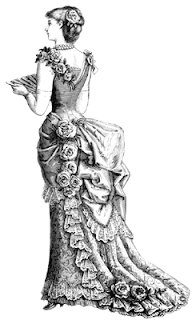This section will display garments of diverse eras focusing specifically on the textiles that give the garment its particular silhouette and design. So significant is the textile chosen for a particular garment, that Christian Dior once proclaimed, “[f]abric not only expresses a designer’s dream, but also stimulates his own ideas. It can be the beginning of an inspiration. Many a dress of mine is born of the fabric alone.”[1]

The image above is a couture creation by John Galliano from the spring 2007 Christian Dior Collection. This image displays how fabric itself inspires ingenious creativity in fashion design. [2]
It has been said that “[t]hroughout history, there have probably been only two real revolutions in fashion styles” [3] The first of these took place during the French Revolution when fashion styles abruptly changed. In the years leading up to the Reign of Terror, French fashion was dictated by “a culture of ostentation and one-upmanship that required the aristocracy to don weighty, brocades, lush velvets and lustrous satins- all in bright, vivid jewel tones and regal, large scale patterns that loudly broadcast their supreme wealth and privilege."[4]
 This image of Marie Antoinette exemplifies the decadence of the French monarchy before the French Revolution: bright, ornate and elaborate fabrics, with full skirt and low-cut bodice. [5]
This image of Marie Antoinette exemplifies the decadence of the French monarchy before the French Revolution: bright, ornate and elaborate fabrics, with full skirt and low-cut bodice. [5]
 This image depicts typical Regency dress with square necklines, puffed sleeves and white muslin fabric.
This image depicts typical Regency dress with square necklines, puffed sleeves and white muslin fabric. 
Up until the early 20th century, “women dressed as they had for centuries- restricted in movement, corseted and caged in their fashions”.[9] The 20th century French couturier Paul Poiret is credited with the first designs that gave women freedom of movement. Poiret “freed their breasts and their legs and literally changed the shape of fashion”.[10] The below image is a Paul Poiret design.

Like Poiret, another famous French fashion designer of the early 20th century was Coco Chanel. "Her simple little black dresses, squarish suits, and almost boyish designs were vastly divergent from the confining and tight-fitting corsets and long dresses with petticoats."[11] Early Chanel fabrics included jersey, silk, linen and cotton fabrics. Postwar Chanel fabrics included heavy wools and tweeds. These textiles were manufactured by textile designers such as Malhia, Burg-Linton, and Bucol. The fabrics give the suit its“boxy shape and luxurious appeal".[12]
 This is a 1964 Chanel suit. The image comes from the Metropolitan Museum of Art Website.
This is a 1964 Chanel suit. The image comes from the Metropolitan Museum of Art Website.

The above image is an updated version of a classic Chanel look from the Chanel Haute Couture 2009 Spring Line. The Image was taken from womenmanagementblog.com. This garment is made up of both natural fibers like classic Chanel pieces however synthetic or artificial fibers have been included which allow for the garment's more modern appeal.
The first synthetic fiber, “artificial silk”, became officially known as Rayon in 1924.[13] Since that time, synthetic fabrics such as nylon, polyester, qiana, spandex and acetate have not only made fabric production more affordable, but have helped to make fabrics easier to care for.[14]


The above images are from the Guess clothing line. The dress and the shirt are machine washable, 95% rayon and 5% spandex. The jeans are of course easy to care for and durable- mostly cotton but with a small amount of the artificial fiber "spandex" to give these jeans their "fit".
Synthetic textiles have also contributed greatly to the ingenuity of 20th century fashion styles and trends. These synthetic fabrics have both inspired creative design and made these creations possible. Below are two designs by John Paul Gaultier that display the inventiveness that synthetic fabrics and modern technology have brought to late 20th century fashion.


[1] Elaine Stone, InFashion Fun! Fame! Fortune! (New York: Fairchild Publications, 2007), p. 101.
[2] http://missstylologist.blogspot.com/2007_01_01_archive.html (February, 2007)
[3]Elaine Stone, InFashion Fun! Fame! Fortune! (New York: Fairchild Publications, 2007), p.24.
[4] Caroline Weber, Queen of Fashion: What Marie Antoinette Wore to the Revolution (New York, Henry Holt and Company, LLC, 2007), p.149 [5]https://blogger.googleusercontent.com/img/b/R29vZ2xl/AVvXsEhVEy3FkbXXVJddzLI1NTjCEuoKB7nqfA1B2UGevgSUgl66cnsf2pDWfGFa8PrcDR31b2itwHTkEqLYwAVOoJXoKOAfB9NCGvye3nAD4fM1o8pqccOhATeaW0mtk2g7uzXPXrrlqguLV3A/s600/marie_antoinette_gravure.jpg [6] http://www.oldandsold.com/articles08/costume-11.shtml (Originally published in 1926) [7] http://www.fashion-era.com/regency_fashion.htm (Pauline Weston Thomas 2001-2009) [14] History of Twentieth Century Fashion Arts, Module 2, Material Trends: The Past, Present and Future of Fashion

No comments:
Post a Comment